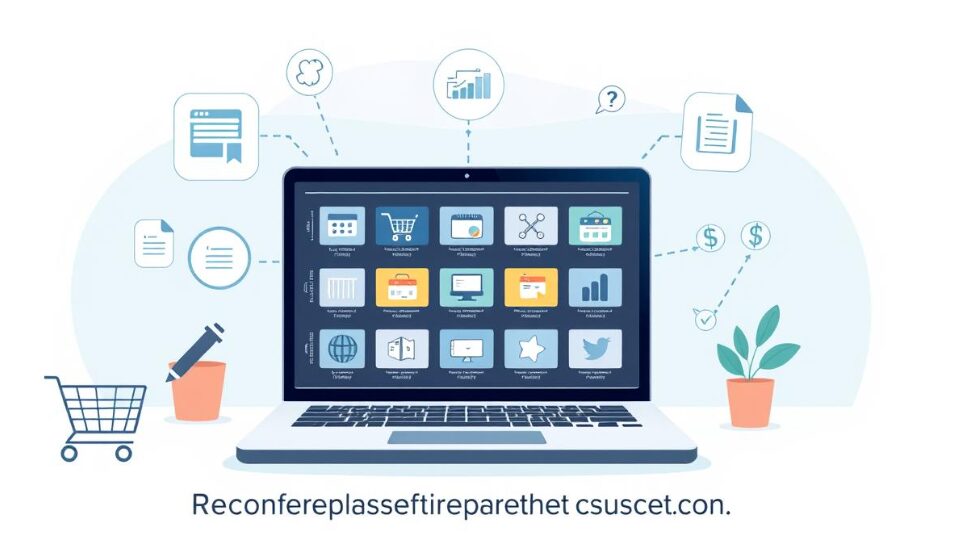In a bustling café in London, Sarah, a skilled massage therapist, felt the strain of running her small business. She excelled in wellness services but found it hard to get new clients and manage bookings. A friend introduced her to service-based e-commerce, and she set up her own online platform. This allowed clients to book and pay easily online.
Her business grew, and she saw how this model made things simpler. It also changed how she connected with her clients. This journey opened new doors for her business.
Now, we start a similar journey. In today’s digital world, service-based e-commerce is key for business success. It boosts your online presence, reaches more people, and engages a wider audience. Let’s explore the basics of service-based e-commerce and find new growth opportunities!
Table of Contents
Key Takeaways
- The growth of service-based e-commerce allows for easy client engagement and appointment management.
- Mobile payments are becoming increasingly popular, with 76% of users relying on their devices for transactions.
- Integrating an online service platform can drastically reduce startup costs for service providers.
- Feedback from tools like Hotjar can enhance website performance and improve customer experience.
- Wide-ranging payment options minimise shopping cart abandonment rates, hereby increasing conversions.
The Rise of Service-Based E-commerce
Service-based e-commerce has changed how businesses work. It lets service-driven e-commerce sites grow online. This new way lets companies offer services online, reaching more people than before. It’s key to know what it is and what’s making it popular.
Defining Service-Based E-commerce
Service-based e-commerce means selling services online, not physical products. This change has brought up many digital service marketplaces. Here, service providers meet clients easily. Customers can buy services like advice or coaching online, making it easier for them.
Trends Driving Growth in Service-Based E-commerce
The move to digital is making service-based e-commerce grow fast. Key trends include:
- It’s now easier for clients to buy services from anywhere.
- More people want services that fit their needs, leading to more custom options.
- More payment options like credit cards and PayPal make it easier for clients to pay.
- Tools like WooCommerce make things run smoother and improve customer interaction.
- Good marketing, like emails and social media, helps businesses get noticed and grow.
With the right plans, businesses can stand out in the digital world. They can attract loyal customers and grow steadily.
Benefits of Embracing E-commerce for Service Providers
Switching to e-commerce brings many benefits for service providers. One big advantage is saving money. By moving online, businesses cut down on costs like rent and staff salaries.
Cost Reduction and Increased Profitability
Online platforms make operations smoother, reducing mistakes and speeding up orders. This leads to more profit. They also help lower marketing costs, as they reach more people without spending a lot on ads.
Enhanced Customer Experience and Accessibility
Online services make life easier for customers. They can read reviews and check out providers’ profiles. This helps them choose wisely. Plus, online platforms are easy to use, even for older people.
Wider Reach and Market Expansion
Online platforms let businesses reach more people. They can sell to customers all over the world. This opens up new markets and chances for growth.
To succeed, businesses need to focus on what customers want. For tips on marketing, see this resource. It offers advice on marketing for service firms online.
Understanding Your Target Audience in Service-Based E-commerce
Finding out who our target audience is is key to success in online service businesses. We must do deep customer behaviour analysis to know what they need and want. This means looking at things like age, gender, and what they earn, as well as their interests and values.
Good market research helps us get this right. It lets us shape our services to fit what our customers need.
Identifying Customer Needs and Behaviour
Knowing our audience well shapes our marketing plans. Demographic data tells us about their buying power and what they like. For instance, how much money they make affects what they might buy.
Knowing where they work helps us pick the best times to offer deals. Using different marketing approaches can reach more people, making our appeal wider.
- Utilising market research to analyse demographics and psychographics
- Running recency, frequency, and monetary analysis on customer databases
- Engaging with primary research methods, including surveys and interviews
The Importance of Personalisation
Today, making things personal is more important than ever for better customer experiences. Studies show 68% of customers want everything to be made just for them. Using AI, we can give them services that really match their needs.
This boosts their happiness and keeps them coming back. Knowing what our competitors do can also help us make our services more personal. Personalised marketing makes customers feel valued and keeps them loyal, leading to more business from them.
Choosing the Right E-commerce Platform
For service-based businesses, picking the right e-commerce platform is key. It’s important to know the different options to find the best one for your business. We’ll look at top platforms for service-based companies and why choosing the right one matters.
Top Platforms for Service-Based Businesses
Here are some top platforms known for their great features:
| Platform | User Experience Rating | Pricing (Monthly, Annually) | Free Trial/Plan | Transaction Fees |
|---|---|---|---|---|
| Wix | 3.9/5 | £16-119 | Free plan available | 2.1% + 20p |
| Shopify | 4.3/5 | £19-259 | 3-day free trial | 1.5%-2% + 25p |
| Squarespace | 4.7/5 | £17-35 | 14-day free trial | 0-3% |
Wix is great for small and diverse businesses. Shopify is perfect for those focusing on e-commerce growth. Squarespace is known for its beautiful designs.
Integration with Existing Systems
Good e-commerce platforms integrate well with other systems. This makes your business run smoothly. Look for platforms that work well with CRM systems and payment gateways.
- Efficient order management
- Bulk updating of order statuses
- Processing returns and refunds
Also, having a strong payment gateway is important. Basic options like PayPal are good, but exploring other options can save money on fees.
Spending time on choosing the right platform is worth it. It helps your business run well. For more tips on starting an online business, check out this resource on dropshipping business ideas.
Implementing Effective E-commerce Strategies
In the fast-evolving world of service-based e-commerce, effective strategies are key to success. By focusing on user-centric design, our platforms can make customer journeys smoother. This ensures visitors easily move from browsing to booking services. A strategic approach includes crafting digital marketing strategies that connect with our target audiences.
Developing a User-Centric Approach
Prioritising user-centric design boosts customer satisfaction and engagement. It helps service providers understand and meet customer needs. With more people shopping on mobiles, making websites mobile-friendly is essential.
Crafting Compelling Digital Marketing Campaigns
Strong digital marketing strategies are vital for visibility and customer interaction. Social media offers great advertising options, like on Instagram and Facebook. It helps service providers market effectively.
Exceptional customer service is key, with 84% of customers saying it influences their buying decisions. AI tools, like chatbots, personalise marketing and improve efficiency. Email marketing campaigns keep customers engaged, leading to more sales. For more on effective marketing campaigns, see this guide on effective marketing campaigns for small businesses.
| Strategy | Impact |
|---|---|
| Mobile Optimisation | Increases mobile sales conversion rates and improves customer retention. |
| Social Media Advertising | Engages a wider audience through targeted campaigns, resulting in higher sales. |
| AI Chatbots | Enhances customer service and streamlines operations, promoting brand loyalty. |
| Email Marketing | Boosts lead nurturing; businesses see measurable increases in customer engagement. |
Maximising Customer Engagement and Retention
In the competitive world of service-based e-commerce, keeping customers engaged and loyal is key. Using customer feedback helps businesses understand what customers want and how to improve. Trends show that people want personal experiences, so we can tailor our services to meet their needs.
Utilising Customer Feedback for Improvement
Collecting and analysing customer feedback opens doors to better products and services. Good customer engagement can boost sales and revenue. In fact, 86% of buyers are willing to pay more for a great experience. Small businesses should follow best practices to collect feedback effectively.
- Set clear goals for feedback collection
- Choose the right communication channels
- Encourage honest feedback
- Respond quickly to customer input
- Use feedback in decision-making
Our team can dive deeper into this topic with studies and resources, like customer feedback for small businesses. By using these strategies, businesses can build stronger relationships with their customers, leading to better retention rates.
Loyalty Programs and Incentives
Creating effective loyalty programs is vital for keeping customers engaged. Keeping existing customers is cheaper than getting new ones, saving up to 25%. Personalised loyalty programs encourage repeat purchases, with 78% of consumers more likely to engage with brands that offer tailored incentives.
Successful loyalty programs include:
- Exclusive discounts and promotions
- Personalised offers based on shopping behaviour
- Reward points for repeat purchases
- Access to special events or products
These efforts not only build loyalty but also increase Customer Lifetime Value (CLV). Advanced ecommerce platforms like ShopWired can help in retaining and engaging customers.
| Customer Engagement Strategy | Benefits |
|---|---|
| Personalised Marketing | Increases customer retention and satisfaction. |
| Feedback Analysis | Identifies areas for improvement and customer needs. |
| Loyalty Programs | Encourages repeat purchases and builds brand loyalty. |
| Exclusive Offers | Enhances customer experience and promotes engagement. |
Service-Based E-commerce: Overcoming Challenges
Service-based e-commerce offers great chances but faces big hurdles like security and privacy. People are more cautious about sharing personal and financial details online. Businesses must focus on digital commerce security by using SSL certificates and following data protection rules. This builds trust and confidence with customers.
Addressing Security and Privacy Concerns
Keeping customer data safe is key for any service business. Good privacy management means being open about how data is handled and using strong encryption. By focusing on security, businesses can lower the risk of data breaches, which are becoming more common. In fact, 46% of British businesses faced a cybersecurity breach last year, showing the need for strong security.
Managing Customer Expectations in a Digital Environment
Meeting customer needs means being clear about services and when they’ll be delivered. Today’s customers want a smooth experience from start to finish. Keeping them updated on service progress helps. Personalising services based on what customers like can also improve their experience. This approach boosts loyalty and encourages repeat business, vital for success in e-commerce.
| Challenge | Impact | Solution |
|---|---|---|
| Data Security Breach | Loss of customer trust and financial implications | Implement SSL certificates and follow data protection regulations |
| High Cart Abandonment Rate | Significant revenue loss | Simplify checkout process and integrate instant support features |
| Poor Customer Communication | Reduced customer satisfaction | Provide regular updates and adopt customer expectation strategies |
| Lack of Personalisation | Failure to retain customers | Use analytics to track user preferences and enhance services |
By tackling these key areas, service-based e-commerce can get stronger and make customers happier. Having a solid Business Continuity Plan helps respond quickly to crises, boosting customer trust in your brand.
Measuring Success in Your E-commerce Strategy
It’s vital to track how well our e-commerce plans are doing. By looking at different E-commerce KPIs, we can see how we’re doing. This helps us make smart choices and grow.
We keep an eye on things like how many people buy, how often they come back, and how much they spend. This lets us know if our strategies are working.
Key Performance Indicators (KPIs) to Monitor
Key performance indicators are key to checking how well our e-commerce is doing. Here are some important ones to watch:
- Conversion Rate: The percentage of website visitors who make a purchase.
- Average Order Value: The average amount spent by customers on a single order.
- Customer Retention Rate: The percentage of customers who return to make additional purchases.
- Return on Investment (ROI): Measurement of the profitability of marketing efforts.
- Cart Abandonment Rate: The percentage of shoppers who add items to their cart but do not complete the purchase.
Continuous Improvement through Analytics
Using data analytics helps us understand our customers and the market better. It gives us insights to improve our strategies. By doing SWOT analyses, we can spot our strengths and weaknesses.
Setting SMART goals helps us track our progress. Regularly updating our strategies keeps us ahead of the game. This way, we can meet our customers’ needs better.
Conclusion
Service-based e-commerce has changed the game for businesses. It offers a chance to grow and make more money in a competitive world. By using smart online growth strategies, we can succeed in the digital world.
We need to make our services better and use digital strategies that meet customer needs. Knowing our audience well helps us create strong bonds and get more repeat business. This focus on improvement can really boost our e-commerce success.
Also, using SEO wisely helps us attract more people and get more sales. As we move forward in the service-based e-commerce world, let’s keep improving and aim for lasting success.
FAQ
What is service-based e-commerce?
Service-based e-commerce lets businesses sell services online. This means they can work without needing a physical place. It helps them reach more people and improve their online image.
What are the main benefits of embracing e-commerce for service providers?
Going online for service providers has many perks. It cuts down costs, makes customers happier by being easy to reach, and opens up a bigger market. This can lead to more money and happier customers.
How do I understand my target audience in service-based e-commerce?
Knowing your audience is key. You need to find out what they want and how they act. This helps you make things they like, which makes them happier and more loyal.
What platforms are best for service-based e-commerce?
Good platforms for service businesses are Shopify, WooCommerce, and Magento. Pick one that fits your needs and works well with other tools like CRM and payment systems.
How can I implement effective e-commerce strategies?
Good strategies focus on what customers want. Make your site easy to use and run marketing campaigns that get people talking about you. Using social media and SEO can help more people find your site.
What strategies can maximise customer engagement and retention?
Keep customers happy by listening to their feedback and making things better. Offer rewards for coming back, which keeps them coming back and attracts new ones too.
How do I address security and privacy concerns in digital service commerce?
Make sure your site is secure with SSL certificates and follow data protection rules. Being open about how you keep customer data safe builds trust and a good reputation.
What key performance indicators (KPIs) should I monitor?
Watch things like how many people buy, how often they come back, and how much they spend. Use tools to understand your data, so you can always get better and stay ahead.







